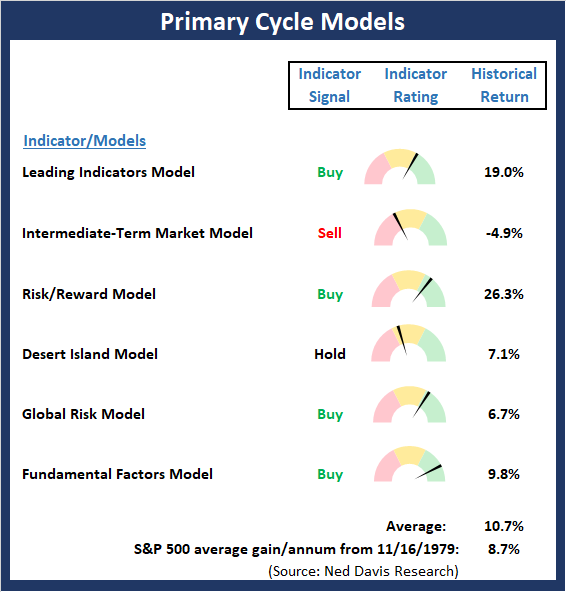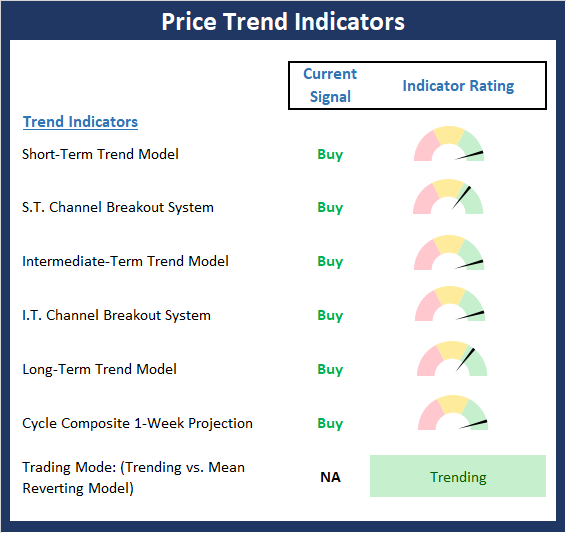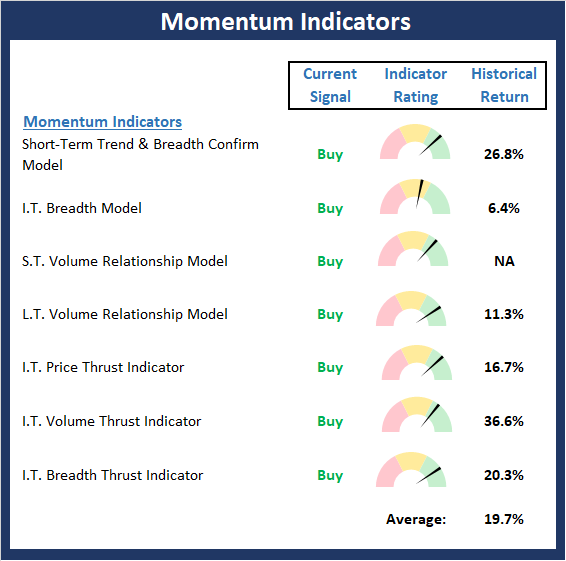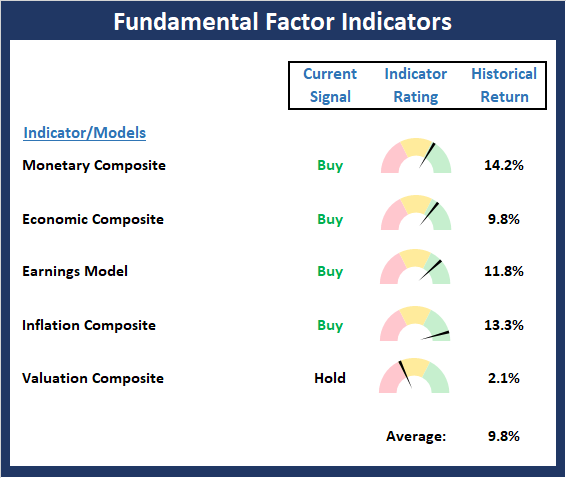Is There More Upside Ahead?
Stocks closed at a fresh cycle high on Friday as the S&P 500 has been enjoying a 7-day win streak, which is the longest in 18 months. Don't look now fans, but the venerable blue-chip index is now just 38 points or 1.3% away from its all-time high. And unless the upcoming earnings season provides a big downside surprise, it appears that the old high is acting like a magnet.
Yet, at this stage of the game, a lot of folks are concerned that stocks have gone too far, too fast and are now "set up" for a fall. But then again, these same folks have been singing this song for a couple months - and a couple hundred S&P points. And while stocks are clearly overbought and the S&P is either quickly approaching or has already exceeded many Wall Street firm's year-end targets, some argue there is still room to the upside.
One such upbeat analyst is Marko Kolanovic. Mr. Kolanovic is a Senior Analyst and the Global Head of Macro Quantitative and Derivatives Strategy at JPMorgan. Cutting to the chase, "the man who moves markets" (as dubbed by CNBC's Fast Money gang), Kolanovic says that new highs are coming soon.
To be clear, I don't listen to very many interviews on the financial networks. I learned a long time ago that in order to be successful in this business, you have to make your own decisions. And since most folks that show up on TV provide little more than their personal opinions on what is going to happen next (often with very little in the way of facts or research rigor), #OnMute is my modus operandi.
When Marko Kolanovic Talks, I Listen
However, when Marko Kolanovic is interviewed on TV or writes a blog post, I sit up and pay attention. Why? Because his research team covers something that is difficult to come by; namely, what the big boys and girls (i.e. the hedgies and systematic traders - the "quants") are doing with their portfolios.
I have long believed that in addition to focusing on my market models, the economy, and the primary market trends, it is important to understand what the major players in the game are doing, and why. But first, you have to know who the players are.
In the early 1980's, the "institutions" such as pension funds, banks, and insurance companies dominated the stock market game. Starting somewhere in the 1990's, the mutual funds became the big players. And today, it is important to pay attention to what the hedge funds and "systematic traders" (think risk parity strategies and all the variations thereof) are doing, because these are the folks running the algos that tend to move markets.
The Big Players Were Caught Flat-Footed
Marko Kolanovic's team studies these quant traders. And the bottom line here is that relative to historical averages, these players are currently underinvested - big time.
Kolanovic notes that according to his team's research, hedge funds' "beta to equity" - meaning their net exposure to the market after the short positions are factored in - is very low. As in an all-time low.
Yep, that's right, while stocks have been ramping, the hedgies have been "playing it safe." And given the shellacking stock market investors received at the end of last year, this makes total sense. Those players who "hedge risks" did their jobs. But apparently, they've been slow to pivot.
As for the "systematic traders" - those players utilizing computer-driven allocation and trading strategies - Kolanovic sees a similar situation. The JPM analyst says the stock market exposure of systematic traders is currently only 30%-40% of their historical average.
While it sounds amazing that some of the market's big, dominant players have been caught flat-footed by the V-Bottom and this year's relentless rally, the data from Marko's team appears to confirm this fact. As such, Kolanovic argues there is plenty of fuel to keep the uptrend's fire burning.
Important Info To Have
To me, this is VERY important information. This helps "esplain" why this rally has refused to yield. Why there have been no pullbacks to speak of. Why the dips - including the intraday dips - have been bought. And why it has been tough to "get in" if you were silly enough to manage the risk of Q4's market debacle by raising some cash.
So, while the major indices could certainly pull back and perhaps test the breakout above important technical levels such as the S&P's 200-day moving average, it will be important to watch the action during such a dip. Unless the fundamental backdrop changes (as in economic growth expectations, inflation, or rates), my guess is that the big players will continue to reallocate funds to the stock market.
Well, at least until the "Sell in May" season comes around - LOL!
Weekly Market Model Review
Now let's turn to the weekly review of my favorite indicators and market models...
The State of the Big-Picture Market Models
I like to start each week with a review of the state of my favorite big-picture market models, which are designed to help me determine which team is in control of the primary trend.

View My Favorite Market Models Online
The Bottom Line:
- There were three positive change to the "Primary Cycle" board this week. First, the Risk/Reward model upticked into positive territory (by a smidge). Next, my "Desert Island Model" improved to neutral (by the skinniest of margins). And finally, the Global Risk Model managed to break into the green zone (again, by a hair). The bottom line is the overall message from the board is much improved. And from my seat, this means the risk of a meaningful decline (i.e. something more than a garden-variety pullback) is reduced.
This week's mean percentage score of my 6 favorite models advanced to 58% from 49.5% last week (Prior readings: 47%, 50%, 47.9%, 45.4%, 40.3%) while the median improved to 65.9% from 50% last week (Prior readings: 50%, 50%, 50%, 46.3%, 42.5%).
The State of the Trend
Once I've reviewed the big picture, I then turn to the "state of the trend." These indicators are designed to give us a feel for the overall health of the current short- and intermediate-term trend models.

View Trend Indicator Board Online
The Bottom Line:
- The Trend board scores a perfect 10.0 this week as all the indicators are positive and all are on buy signals. Even the Trading Mode model has managed to confirm that the indices are now in a trending environment. While on the surface, this may appear to be a "late" signal, the "mode" model isn't designed to issue buy/sell signals, but rather to confirm which type of environment the market is experiencing. So, with the model now having flipped to "trending," investors may want to shift to a set of strategies favoring trend-following as opposed to a mean-reverting approach.
The State of Internal Momentum
Next up are the momentum indicators, which are designed to tell us whether there is any "oomph" behind the current trend.

View Momentum Indicator Board Online
The Bottom Line:
- The Momentum board is also in very good shape here with all 7 models on buy signals and an historical return pushing 20% per annum, which is nearly double the historical trend. As I've been saying, the big takeaway from the strong momentum readings is this remains a buy-the-dip environment.
The State of the "Trade"
We also focus each week on the "early warning" board, which is designed to indicate when traders might start to "go the other way" -- for a trade.

View Early Warning Indicator Board Online
The Bottom Line:
- The Early Warning board continues to act as a warning flag as none of the indicators are on buy signals at this time and there are no positive readings. Thus, I'm going to suggest that the table is in now set for the bears. The stars are not (yet?) aligned for a counter-trend move, but the environment is becoming ripe for one.
The State of the Macro Picture
Now let's move on to the market's fundamental factors - the indicators designed to tell us the state of the big-picture market drivers including monetary conditions, the economy, inflation, and valuations.

View Fundamental Indicator Board Online
The Bottom Line:
- There was one improvement on the Fundamentals board this week. As we noted last week, the Monetary Composite continues to improve and this week moved up into the positive zone. All in, as I've been saying, I believe the Fundamental board continues to favor the bulls.
Thought For The Day:
If it's fun, it's not work. And if it's not fun, it will never work. -Hobie Alter
Wishing you green screens and all the best for a great day,

David D. Moenning
Founder, Chief Investment Officer
Heritage Capital Research
HCR Focuses on a Risk-Managed Approach to Investing
What Risk Management Can and Cannot Do
HCR Awarded Top Honors in 2018 NAAIM Shark Tank Portfolio Strategy Competition
Each year, NAAIM (National Association of Active Investment Managers) hosts a competition to identify the best actively managed investment strategies. In April, HCR's Dave Moenning took home first place for his flagship risk management strategy.
Disclosures
At the time of publication, Mr. Moenning held long positions in the following securities mentioned: None - Note that positions may change at any time.
Leading Indicators Model: A group of indicators that have historically shown tendencies to lead the market at major turning points.
Intermediate-Term Market Model: A composite model (model of models) focused on trend and momentum indicators which has been designed to provide identify intermediate-term trading opportunities.
Risk/Reward Model: A model-of-models intended to provide an overall view of the state of the risk/reward environment. The model includes tape, monetary, and sentiment indicators as well as 7 big-picture market model readings.
Desert Island Model: If I was stranded on a desert island with access to only one market model to manage money with, this would be the model. The model is a comprehensive model-of-models comprised of trend, momentum, mean reversion, economic, monetary, sentiment, and factor-based indicators/models.
External Factors Model: A model-of-models designed to provide a reading on the "macro state" of the market environment. The model is comprised of indicators/models in the areas of various index yields, industrial production, investors sentiment, and historic volatility.
Short-Term Trend-and-Breadth Signal Explained: History shows the most reliable market moves tend to occur when the breadth indices are in gear with the major market averages. When the breadth measures diverge, investors should take note that a trend reversal may be at hand. This indicator incorporates NDR's All-Cap Dollar Weighted Equity Series and A/D Line. From 1998, when the A/D line is above its 5-day smoothing and the All-Cap Equal Weighted Equity Series is above its 25-day smoothing, the equity index has gained at a rate of +32.5% per year. When one of the indicators is above its smoothing, the equity index has gained at a rate of +13.3% per year. And when both are below, the equity index has lost +23.6% per year.
Channel Breakout System Explained: The short-term and intermediate-term Channel Breakout Systems are modified versions of the Donchian Channel indicator. According to Wikipedia, "The Donchian channel is an indicator used in market trading developed by Richard Donchian. It is formed by taking the highest high and the lowest low of the last n periods. The area between the high and the low is the channel for the period chosen."
Intermediate-Term Trend-and-Breadth Signal Explained: This indicator incorporates NDR's All-Cap Dollar Weighted Equity Series and A/D Line. From 1998, when the A/D line is above its 45-day smoothing and the All-Cap Equal Weighted Equity Series is above its 45-day smoothing, the equity index has gained at a rate of +17.6% per year. When one of the indicators is above its smoothing, the equity index has gained at a rate of +6.5% per year. And when both are below, the equity index has lost -1.3% per year.
Cycle Composite Projections: The cycle composite combines the 1-year Seasonal, 4-year Presidential, and 10-year Decennial cycles. The indicator reading shown uses the cycle projection for the upcoming week.
Trading Mode Indicator: This indicator attempts to identify whether the current trading environment is "trending" or "mean reverting." The indicator takes the composite reading of the Efficiency Ratio, the Average Correlation Coefficient, and Trend Strength models.
Volume Relationship Models: These models review the relationship between "supply" and "demand" volume over the short- and intermediate-term time frames.
Price Thrust Model Explained: This indicator measures the 3-day rate of change of the Value Line Composite relative to the standard deviation of the 30-day average. When the Value Line's 3-day rate of change have moved above 0.5 standard deviation of the 30-day average ROC, a "thrust" occurs and since 2000, the Value Line Composite has gained ground at a rate of +20.6% per year. When the indicator is below 0.5 standard deviation of the 30-day, the Value Line has lost ground at a rate of -10.0% per year. And when neutral, the Value Line has gained at a rate of +5.9% per year.
Volume Thrust Model Explained: This indicator uses NASDAQ volume data to indicate bullish and bearish conditions for the NASDAQ Composite Index. The indicator plots the ratio of the 10-day total of NASDAQ daily advancing volume (i.e., the total volume traded in stocks which rose in price each day) to the 10-day total of daily declining volume (volume traded in stocks which fell each day). This ratio indicates when advancing stocks are attracting the majority of the volume (readings above 1.0) and when declining stocks are seeing the heaviest trading (readings below 1.0). This indicator thus supports the case that a rising market supported by heavier volume in the advancing issues tends to be the most bullish condition, while a declining market with downside volume dominating confirms bearish conditions. When in a positive mode, the NASDAQ Composite has gained at a rate of +38.3% per year, When neutral, the NASDAQ has gained at a rate of +13.3% per year. And when negative, the NASDAQ has lost at a rate of -14.89% per year.
Breadth Thrust Model Explained: This indicator uses the number of NASDAQ-listed stocks advancing and declining to indicate bullish or bearish breadth conditions for the NASDAQ Composite. The indicator plots the ratio of the 10-day total of the number of stocks rising on the NASDAQ each day to the 10-day total of the number of stocks declining each day. Using 10-day totals smooths the random daily fluctuations and gives indications on an intermediate-term basis. As expected, the NASDAQ Composite performs much better when the 10-day A/D ratio is high (strong breadth) and worse when the indicator is in its lower mode (weak breadth). The most bullish conditions for the NASDAQ when the 10-day A/D indicator is not only high, but has recently posted an extreme high reading and thus indicated a thrust of upside momentum. Bearish conditions are confirmed when the indicator is low and has recently signaled a downside breadth thrust. In positive mode, the NASDAQ has gained at a rate of +22.1% per year since 1981. In a neutral mode, the NASDAQ has gained at a rate of +14.5% per year. And when in a negative mode, the NASDAQ has lost at a rate of -6.4% per year.
Short-Term Overbought/sold Indicator: This indicator is the current reading of the 14,1,3 stochastic oscillator. When the oscillator is above 80 and the %K is above the %D, the indicator gives an overbought reading. Conversely, when the oscillator is below 20 and %K is below its %D, the indicator is oversold.
Intermediate-Term Overbought/sold Indicator: This indicator is a 40-day RSI reading. When above 57.5, the indicator is considered overbought and wnen below 45 it is oversold.
Mean Reversion Model: This is a diffusion model consisting of five indicators that can produce buy and sell signals based on overbought/sold conditions.
VIX Indicator: This indicators looks at the current reading of the VIX relative to standard deviation bands. When the indicator reaches an extreme reading in either direction, it is an indication that a market trend could reverse in the near-term.
Short-Term Sentiment Indicator: This is a model-of-models composed of 18 independent sentiment indicators designed to indicate when market sentiment has reached an extreme from a short-term perspective. Historical analysis indicates that the stock market's best gains come after an environment has become extremely negative from a sentiment standpoint. Conversely, when sentiment becomes extremely positive, market returns have been subpar.
Intermediate-Term Sentiment Indicator: This is a model-of-models composed of 7 independent sentiment indicators designed to indicate when market sentiment has reached an extreme from a intrmediate-term perspective. Historical analysis indicates that the stock market's best gains come after an environment has become extremely negative from a sentiment standpoint. Conversely, when sentiment becomes extremely positive, market returns have been subpar.
Long-Term Sentiment Indicator: This is a model-of-models composed of 6 independent sentiment indicators designed to indicate when market sentiment has reached an extreme from a long-term perspective. Historical analysis indicates that the stock market's best gains come after an environment has become extremely negative from a sentiment standpoint. Conversely, when sentiment becomes extremely positive, market returns have been subpar.
Absolute Monetary Model Explained: The popular cliche, "Don't fight the Fed" is really a testament to the profound impact that interest rates and Fed policy have on the market. It is a proven fact that monetary conditions are one of the most powerful influences on the direction of stock prices. The Absolute Monetary Model looks at the current level of interest rates relative to historical levels and Fed policy.
Relative Monetary Model Explained: The "relative" monetary model looks at monetary indicators relative to recent levels as well as rates of change and Fed Policy.
Economic Model Explained: During the middle of bull and bear markets, understanding the overall health of the economy and how it impacts the stock market is one of the few truly logical aspects of the stock market. When our Economic model sports a "positive" reading, history (beginning in 1965) shows that stocks enjoy returns in excess of 21% per year. Yet, when the model's reading falls into the "negative" zone, the S&P has lost nearly -25% per year. However, it is vital to understand that there are times when good economic news is actually bad for stocks and vice versa. Thus, the Economic model can help investors stay in tune with where we are in the overall economic cycle.
Inflation Model Explained: They say that "the tape tells all." However, one of the best "big picture" indicators of what the market is expected to do next is inflation. Simply put, since 1962, when the model indicates that inflationary pressures are strong, stocks have lost ground. Yet, when inflationary pressures are low, the S&P 500 has gained ground at a rate in excess of 13%. The bottom line is inflation is one of the primary drivers of stock market returns.
Valuation Model Explained: If you want to get analysts really riled up, you need only to begin a discussion of market valuation. While the question of whether stocks are overvalued or undervalued appears to be a simple one, the subject is actually extremely complex. To simplify the subject dramatically, investors must first determine if they should focus on relative valuation (which include the current level of interest rates) or absolute valuation measures (the more traditional readings of Price/Earnings, Price/Dividend, and Price/Book Value). We believe that it is important to recognize that environments change. And as such, the market's focus and corresponding view of valuations are likely to change as well. Thus, we depend on our Valuation Models to help us keep our eye on the ball.
Disclosures
The opinions and forecasts expressed herein are those of Mr. David Moenning and may not actually come to pass. Mr. Moenning's opinions and viewpoints regarding the future of the markets should not be construed as recommendations. The analysis and information in this report is for informational purposes only. No part of the material presented in this report is intended as an investment recommendation or investment advice. Neither the information nor any opinion expressed constitutes a solicitation to purchase or sell securities or any investment program.
Any investment decisions must in all cases be made by the reader or by his or her investment adviser. Do NOT ever purchase any security without doing sufficient research. There is no guarantee that the investment objectives outlined will actually come to pass. All opinions expressed herein are subject to change without notice. Neither the editor, employees, nor any of their affiliates shall have any liability for any loss sustained by anyone who has relied on the information provided.
Mr. Moenning may at times have positions in the securities referred to and may make purchases or sales of these securities while publications are in circulation. Positions may change at any time.
The analysis provided is based on both technical and fundamental research and is provided "as is" without warranty of any kind, either expressed or implied. Although the information contained is derived from sources which are believed to be reliable, they cannot be guaranteed.
Investments in equities carry an inherent element of risk including the potential for significant loss of principal. Past performance is not an indication of future results.

